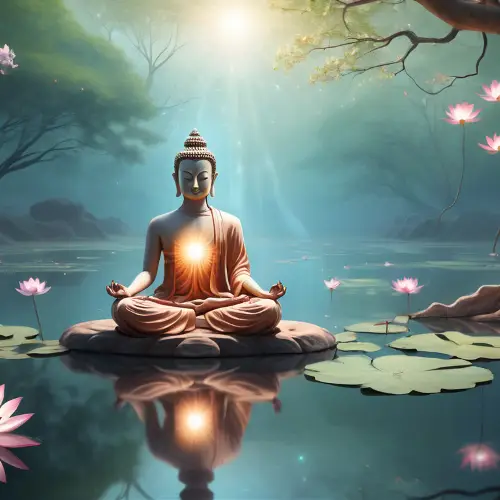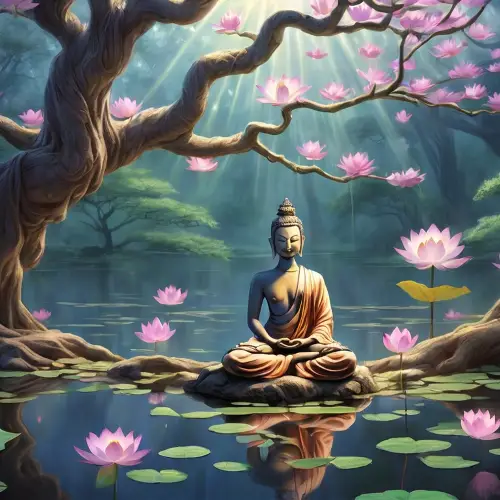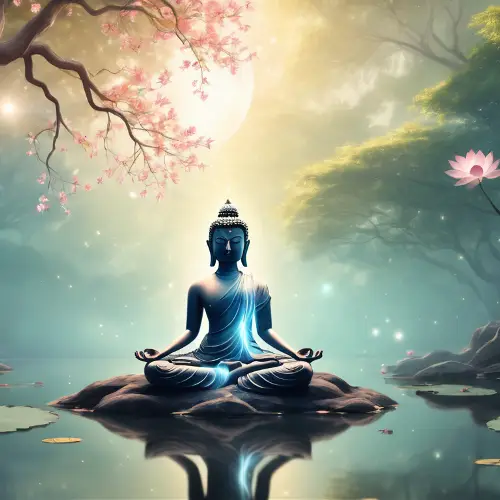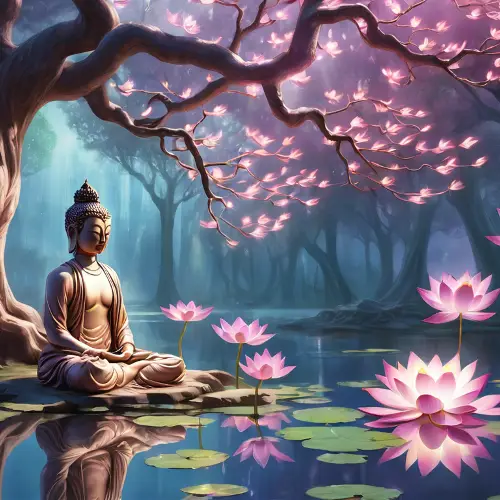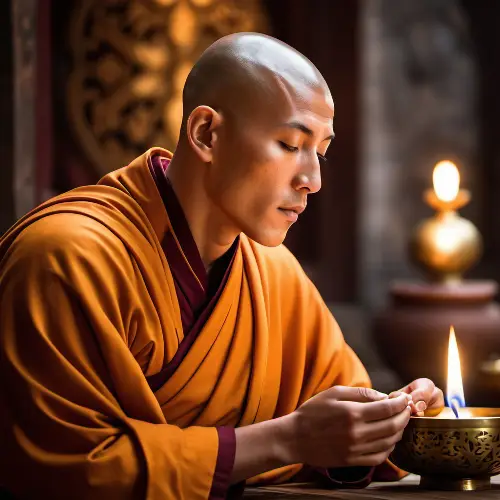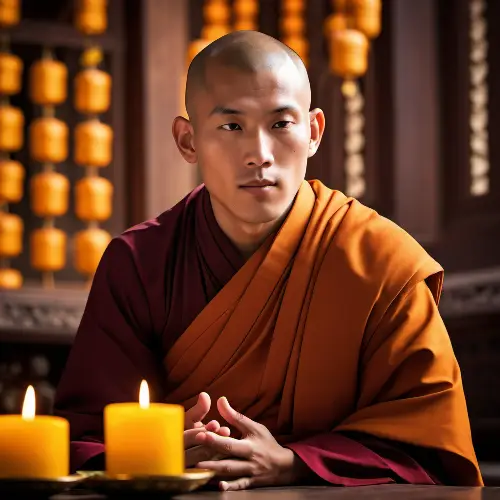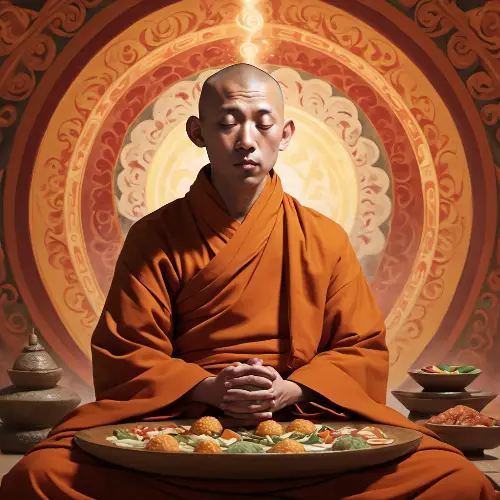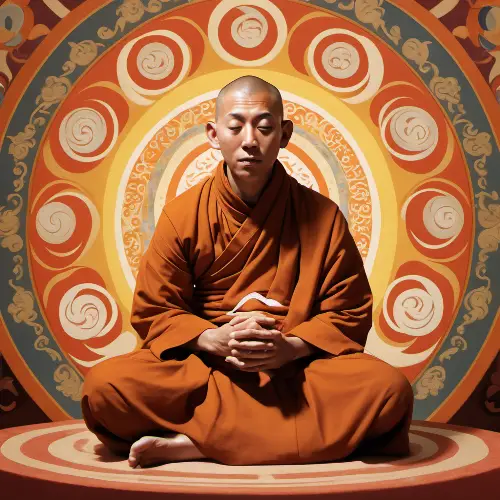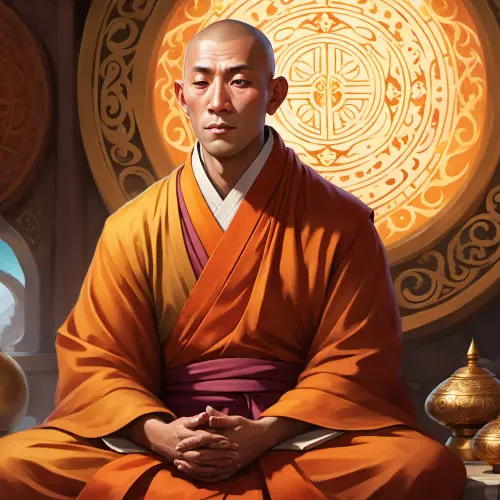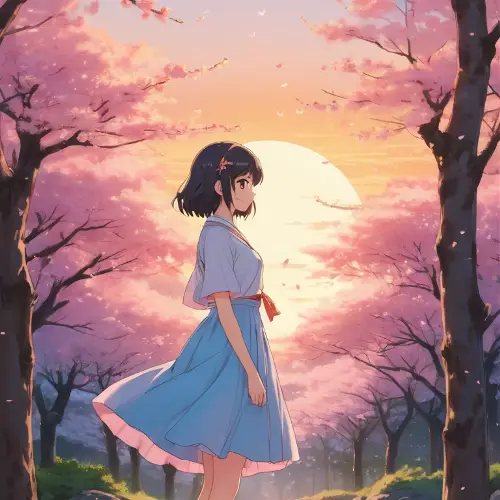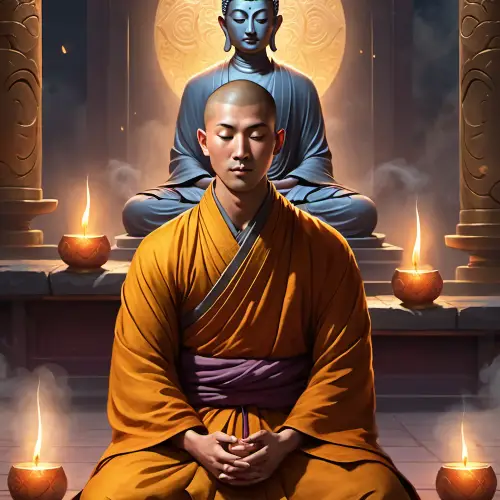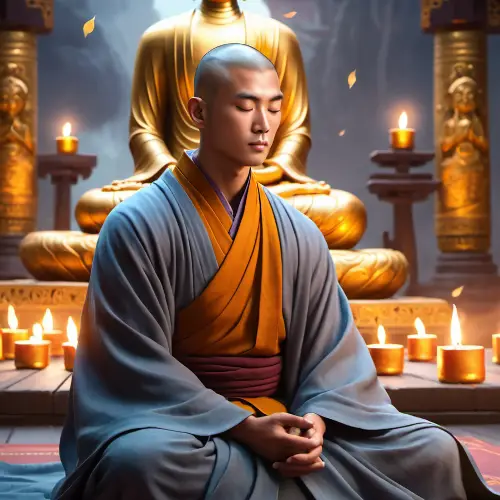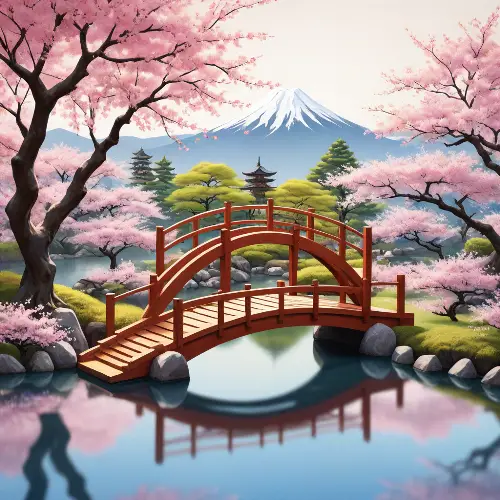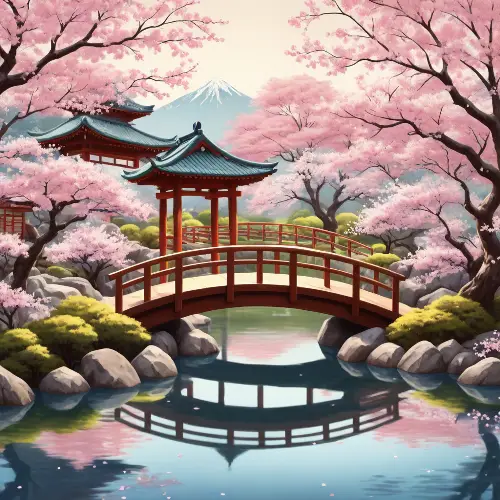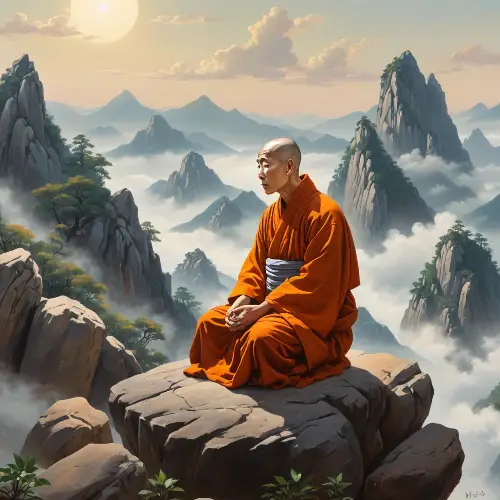An animated scene unfolds in a Zen garden where cherry blossoms gently fall around a meditating monk. The monks posture gradually transitions into different meditative poses, and the lanterns light flickers softly, creating a serene atmosphere. The changing colors of the sky symbolize the passing of time.
More Like This
An animated scene unfolds in a Zen garden where cherry blossoms gently fall around a meditating monk. The monks posture gradually transitions into different meditative poses, and the lanterns light flickers softly, creating a serene atmosphere. The changing colors of the sky symbolize the passing of time.
An animated scene unfolds in a Zen garden where cherry blossoms gently fall around a meditating monk. The monks posture gradually transitions into different meditative poses, and the lanterns light flickers softly, creating a serene atmosphere. The changing colors of the sky symbolize the passing of time.
An animated scene unfolds in a Zen garden where cherry blossoms gently fall around a meditating monk. The monks posture gradually transitions into different meditative poses, and the lanterns light flickers softly, creating a serene atmosphere. The changing colors of the sky symbolize the passing of time.
A serene illustration of a meditating monk seated in a tranquil monastery garden, (Zen atmosphere:1.3), with the ethereal images of lavish feasts and piles of gold coins attempting to invade his space, (temptation:1.2). His expression is one of profound peace, (inner harmony:1.5), unaffected by the spectral allure of the material desires, (asceticism:1.4). The artwork combines the styles of Sesshū Tōyō and Tawaraya Sōtatsu, featuring (Japanese ink wash painting:1.2), with a subtle play of light suggesting spiritual illumination, (enlightened being:1.3).
A serene illustration of a meditating monk seated in a tranquil monastery garden, (Zen atmosphere:1.3), with the ethereal images of lavish feasts and piles of gold coins attempting to invade his space, (temptation:1.2). His expression is one of profound peace, (inner harmony:1.5), unaffected by the spectral allure of the material desires, (asceticism:1.4). The artwork combines the styles of Sesshū Tōyō and Tawaraya Sōtatsu, featuring (Japanese ink wash painting:1.2), with a subtle play of light suggesting spiritual illumination, (enlightened being:1.3).
A Japanese Zen garden with a bonsai tree, raked sand, moss-covered stones, wooden walkways, and bamboo trees in the background. The light is soft and peaceful.
Visual representation of a serene moment with a Bodhisattva meditating under the branches of a tree, a peaceful pond nearby reflecting the beauty of lotus flowers, while a luminous aura surrounds the enlightened being
Visual representation of a serene moment with a Bodhisattva meditating under the branches of a tree, a peaceful pond nearby reflecting the beauty of lotus flowers, while a luminous aura surrounds the enlightened being
A whimsical, animated scene depicting a monk in meditation, his face a picture of contentment and resolve amidst the swirling visual representations of culinary delights and wealth. The temptations appear as almost cartoon-like caricatures, emphasizing their inability to disturb the monk's inner peace. The background is a stylized, peaceful monastery setting, with elements that glow softly, reflecting the monk's inner light and the joy of spiritual fulfillment over worldly pleasures.
A whimsical, animated scene depicting a monk in meditation, his face a picture of contentment and resolve amidst the swirling visual representations of culinary delights and wealth. The temptations appear as almost cartoon-like caricatures, emphasizing their inability to disturb the monk's inner peace. The background is a stylized, peaceful monastery setting, with elements that glow softly, reflecting the monk's inner light and the joy of spiritual fulfillment over worldly pleasures.
A whimsical, animated scene depicting a monk in meditation, his face a picture of contentment and resolve amidst the swirling visual representations of culinary delights and wealth. The temptations appear as almost cartoon-like caricatures, emphasizing their inability to disturb the monk's inner peace. The background is a stylized, peaceful monastery setting, with elements that glow softly, reflecting the monk's inner light and the joy of spiritual fulfillment over worldly pleasures.
A whimsical, animated scene depicting a monk in meditation, his face a picture of contentment and resolve amidst the swirling visual representations of culinary delights and wealth. The temptations appear as almost cartoon-like caricatures, emphasizing their inability to disturb the monk's inner peace. The background is a stylized, peaceful monastery setting, with elements that glow softly, reflecting the monk's inner light and the joy of spiritual fulfillment over worldly pleasures.
At the January ritual's zenith, a tranquil garden is illuminated by lanterns, cherry blossoms in full bloom, a contemplative figure in traditional attire engaged in a ritualistic tea ceremony, a harmonious and peaceful atmosphere, 3D rendering, --ar 16:9 --v 5
A calm Chinese monk stands at the entrance of the Zen courtyard. There are bamboos and ancient trees around the Zen courtyard. A medium shot .
A tranquil Zen garden with cherry blossom trees, a small bridge, and koi fish swimming in a pond.
A peaceful natural scene, such as a quiet garden or a leisurely body of water, with a soft glow in the background. There are words \"Garden of the Soul\" in the middle of the picture, highlighting the joy and tranquility of meditation. film realistic style
An animated monk in deep meditation, with ethereal versions of sumptuous feasts and piles of gold circling around him, yet repelled by the sheer power of his mindfulness. The style is whimsical and exaggerated, capturing the spiritual triumph over material desires. The monk's expression is one of serene concentration, and the background is a playful interpretation of a temple garden
a deep dense forest in that dense forest a old buddhist monk meditating under a tree , moon light falling on this monk by the light the monk shine lika a moon light , in background forest animals see that monk,those animals are stunned by seeing the monk,color grading moon night, - camera zoom in
A calm old Chinese monk stands at the entrance of the Zen courtyard. There are bamboos and ancient trees around the Zen courtyard. A close shot .
little monk old monk Monks Courtyard chat Zen dialogue temple sunset kind smile Practice experience Kindness and wisdom quiet life 3D animation
A young monk was sitting and chanting sutras by the pond. There were lotus flowers and lotus leaves in the pond, the sunset in the sky, and the snow-capped mountains in the distance. Japanese anime style.
A young monk sat by the pond and chanted sutras. There were lotus flowers and lotus leaves in the pond, the sunset in the sky, and mountains in the distance. anime style.
Amidst the serene backdrop of a cherry blossom forest at sunset, envision a captivating scene featuring a 20-year-old anime-style character in a state of undress, tastefully depicted to convey the beauty of nature. The soft hues of the setting sun cast a warm glow on the delicate blossoms, creating an atmosphere of tranquility and gentle allure. This surreal and romantic moment captures the essence of artistic expression within the anime aesthetic, transcending the conventional boundaries of modesty
In the midground, within the serenity of a Buddhist temple, a young and handsome monk, eyes closed, clad in a gray robe, sits in meditation on a cushioned mat. Behind him, the imposing figure of a golden Buddha statue towers above, encircled by smoke and illuminated by the flickering light of candles. The scene is set against a backdrop of dark, muted tones.
A serene illustration of a meditating monk seated in lotus position, surrounded by a surreal display of floating delicacies and shimmering coins, all of which seem to dissolve into a mist of insignificance around his tranquil aura. The monk's face is a portrait of peaceful defiance, unfazed by the temptations of food and wealth. His simple robes contrast with the complexity of the dissipating temptations, all rendered in a vibrant, animated style with exaggerated features for dramatic effect.
A serene illustration of a meditating monk seated in lotus position, surrounded by a surreal display of floating delicacies and shimmering coins, all of which seem to dissolve into a mist of insignificance around his tranquil aura. The monk's face is a portrait of peaceful defiance, unfazed by the temptations of food and wealth. His simple robes contrast with the complexity of the dissipating temptations, all rendered in a vibrant, animated style with exaggerated features for dramatic effect.
Watercolor style.A young monk sat by the pond and chanted sutras. There were lotus flowers and lotus leaves in the pond. It was dark, there were moon and stars in the sky, and there were snow-capped mountains in the distance.
There are Zen temples White SLATE brick A Buddhist master with an Asian face The Buddhist gate is pure springtime Some mountain animals
There are Zen temples White SLATE brick A Buddhist master with an Asian face The Buddhist gate is pure springtime Some mountain animals
There are Zen temples White SLATE brick A Buddhist master with an Asian face The Buddhist gate is pure springtime Some mountain animals
Create a scenario where a cute little 8-year-old Chinese monk, wearing a set of monks clothes and a string of Buddha beads around his neck, walks in a sunny garden with a happy smile on his face.masterpiece, best quality, masterpiece,best quality,official art,extremely detailed CG unity 8k wallpaper,
The visual representation embodies the essence of Eastern artistic principles, showcasing a serene Japanese garden with a traditional wooden bridge over a tranquil pond, vibrant cherry blossom trees framing the scene,
Creating a black and white line art image requires a visual artist or graphic designer, as it involves translating the described scene into a 2D representation with lines and shading. However, I can provide a simplified textual representation of the scene in a style reminiscent of a black and white line art description: Title: \Vipassana Serenity\ Description: Imagine a sweeping landscape in Myanmar, where a Vipassana meditation center stands as a beacon of tranquility. The retreat is nestled amid rolling hills and framed by the graceful curves of traditional Burmese architecture. Individual meditation rooms dot the scene, each a simple, standalone structure adorned with cultural nuances. Diverse meditators engage in profound introspection within their private sanctuaries. Through open windows and doors, glimpses reveal individuals in varied postures, symbolizing the unity in their solitary pursuit of inner peace. Natural light delicately illuminates the scene, casting shadows that dance across the meditation rooms and the surrounding landscape. Symbolic elements such as lotus flowers and prayer flags add a touch of cultural richness to the image. Harmony with nature prevails, as swaying trees and the gentle ripples of a nearby pond create a serene backdrop. The time of day, whether the soft glow of dawn, the warmth of midday sunlight, or the tranquil hues of dusk, sets the mood for this visual ode to Vipassana meditation.
This painting depicts a Chinese monk meditating at the summit of a mountain. The monk, possibly dressed in a traditional robe, sits on sturdy rocks in a dignified and focused posture. The surroundings at the mountain peak exude a serene atmosphere, with sunlight breaking through the clouds and casting a gentle glow upon the monk. Mountain ranges extend into the distance, shrouded in mist, creating a majestic natural scene. The monk, with closed eyes and hands clasped in meditation, appears deeply immersed in contemplation. The entire scene, crafted with the artist's skillful techniques, portrays the process of a religious practitioner seeking inspiration and tranquility at the pinnacle of a high mountain. This artwork may convey a serene ambiance where religious beliefs, meditation, and nature harmoniously come together.
Create a visual masterpiece that encapsulates the profound tranquility of Vipassana meditation within the confines of a traditional pagoda. Picture a serene landscape where a majestic pagoda, adorned with intricate details, stands as a haven for introspection. Pagoda Overview: Begin with an exterior view of the pagoda, showcasing its grandeur against the backdrop of a calm natural setting. Emphasize traditional architectural details, such as tiered roofs and ornate spires, to evoke a sense of sacredness. Individual Meditation Cells: Zoom in to depict the interior of the pagoda, revealing individual meditation cells. Each cell should exude simplicity and spiritual ambiance, with minimalistic furnishings, soft lighting, and a serene atmosphere conducive to meditation. Meditators in Silence: Populate the cells with Vipassana meditators engaged in silent contemplation. Illustrate various meditation postures, such as seated on cushions or meditation benches, with their eyes closed and a focused yet serene expression. Highlight the diversity of practitioners. Play of Light: Use the play of natural light within the pagoda to create a peaceful and meditative ambiance. Show how light filters through intricately designed windows, casting gentle rays on the meditators and the surroundings. Symbolic Elements: Integrate symbolic elements like lotus flowers, traditional meditation tools, or subtle patterns on the pagoda walls, adding depth and cultural significance to the scene. Harmony with Nature: Surround the pagoda with elements of nature – perhaps glimpses of a tranquil garden, swaying trees, or a reflective pond. Reinforce the idea that the pagoda is in harmony with its natural surroundings. Time of Day: Consider the time of day to set the mood – whether its the soft hues of dawn, the warmth of midday sunlight, or the serene tones of dusk. Align the chosen time with the meditative atmosphere you wish to convey.
Floral Silhouette Sticker Product Label, A uniquely shaped sticker label resembling the graceful outline of a flower, designed with precision to capture the elegance of petals. Crafted from high-quality sticker material, the label offers a smooth and sleek texture, enhancing the overall tactile experience. Placed against a backdrop of a sunlit garden, the floral silhouette label basks in gentle sunlight, creating a play of shadows and highlights that emphasize its sophisticated contours. The mood is serene, resonating with the tranquility of a blossoming garden. The atmosphere exudes sophistication and natural beauty. Soft rustlings of leaves and the occasional song of birds create a harmonious soundtrack, while the subtle fragrance of blooming flowers infuses the air. The overall tone is refined and timeless, establishing a connection between the product and the enduring allure of nature. The lighting effect on the label is a subtle dance of sunlight, casting delicate highlights and shadows that accentuate the clean lines of the floral silhouette. The warm rays add a touch of warmth to the label, creating a visual appeal that is both modern and classic. Shadows gracefully follow the curves of the silhouette, contributing to the overall elegance of the design. --ar 2:3 --c 11 --s 350 --q 2
Creating a photorealistic image that captures the essence of \"Zen\" can be a rewarding artistic endeavor. Zen, which is deeply rooted in Buddhist philosophy, emphasizes simplicity, naturalness, and a sense of tranquility. To visualize this concept, you would typically want to focus on natural elements, minimalist design, and a peaceful ambiance. Here is a step-by-step guide to help you create a photorealistic Zen-themed image: Choose Your Main Subject: Consider subjects that evoke calmness and serenity, such as a Zen garden, a simple still life with a bonsai tree, or smooth stones in sand. Select a Color Palette: Stick to muted, earthy tones like soft greens, warm browns, and grays to reinforce a natural and calming aesthetic. Plan the Composition: Aim for a balanced and harmonious composition. Use the rule of thirds to position key elements. Leave plenty of negative space to enhance the Zen concept of ma (negative space), which emphasizes the things that aren't there as much as the things that are. Set the Lighting: Soft, diffused lighting can help to create a serene mood. Consider the time of day that best reflects the peace of Zen, like early morning or dusk. Incorporate Texture: Detailing with texture such as raked sand patterns or the bark of a bonsai tree will add to the realism. Add Simplistic Elements: Elements like a single leaf or pebble can symbolize the Zen principle of kanso (simplicity). Focus on Detail and Realism: Pay attention to small details like shadows, reflections, and textures to enhance the photorealistic quality. Post-Processing: Use photo editing software to fine-tune colors, contrast, and saturation, and to ensure a natural look is maintained. Review and Reflect: Look at the image as a whole and consider if it truly conveys a sense of Zen. It should inspire a viewer to feel more mindful, present, and at peace.
Creating a photorealistic image that captures the essence of \"Zen\" can be a rewarding artistic endeavor. Zen, which is deeply rooted in Buddhist philosophy, emphasizes simplicity, naturalness, and a sense of tranquility. To visualize this concept, you would typically want to focus on natural elements, minimalist design, and a peaceful ambiance. Here is a step-by-step guide to help you create a photorealistic Zen-themed image: Choose Your Main Subject: Consider subjects that evoke calmness and serenity, such as a Zen garden, a simple still life with a bonsai tree, or smooth stones in sand. Select a Color Palette: Stick to muted, earthy tones like soft greens, warm browns, and grays to reinforce a natural and calming aesthetic. Plan the Composition: Aim for a balanced and harmonious composition. Use the rule of thirds to position key elements. Leave plenty of negative space to enhance the Zen concept of ma (negative space), which emphasizes the things that aren't there as much as the things that are. Set the Lighting: Soft, diffused lighting can help to create a serene mood. Consider the time of day that best reflects the peace of Zen, like early morning or dusk. Incorporate Texture: Detailing with texture such as raked sand patterns or the bark of a bonsai tree will add to the realism. Add Simplistic Elements: Elements like a single leaf or pebble can symbolize the Zen principle of kanso (simplicity). Focus on Detail and Realism: Pay attention to small details like shadows, reflections, and textures to enhance the photorealistic quality. Post-Processing: Use photo editing software to fine-tune colors, contrast, and saturation, and to ensure a natural look is maintained. Review and Reflect: Look at the image as a whole and consider if it truly conveys a sense of Zen. It should inspire a viewer to feel more mindful, present, and at peace.
Creating a photorealistic image that captures the essence of \"Zen\" can be a rewarding artistic endeavor. Zen, which is deeply rooted in Buddhist philosophy, emphasizes simplicity, naturalness, and a sense of tranquility. To visualize this concept, you would typically want to focus on natural elements, minimalist design, and a peaceful ambiance. Here is a step-by-step guide to help you create a photorealistic Zen-themed image: Choose Your Main Subject: Consider subjects that evoke calmness and serenity, such as a Zen garden, a simple still life with a bonsai tree, or smooth stones in sand. Select a Color Palette: Stick to muted, earthy tones like soft greens, warm browns, and grays to reinforce a natural and calming aesthetic. Plan the Composition: Aim for a balanced and harmonious composition. Use the rule of thirds to position key elements. Leave plenty of negative space to enhance the Zen concept of ma (negative space), which emphasizes the things that aren't there as much as the things that are. Set the Lighting: Soft, diffused lighting can help to create a serene mood. Consider the time of day that best reflects the peace of Zen, like early morning or dusk. Incorporate Texture: Detailing with texture such as raked sand patterns or the bark of a bonsai tree will add to the realism. Add Simplistic Elements: Elements like a single leaf or pebble can symbolize the Zen principle of kanso (simplicity). Focus on Detail and Realism: Pay attention to small details like shadows, reflections, and textures to enhance the photorealistic quality. Post-Processing: Use photo editing software to fine-tune colors, contrast, and saturation, and to ensure a natural look is maintained. Review and Reflect: Look at the image as a whole and consider if it truly conveys a sense of Zen. It should inspire a viewer to feel more mindful, present, and at peace.
an old buddhist monk meditating under a one of a tree of thick dense forest ,a group of villagers standing near to that buddhist monk














